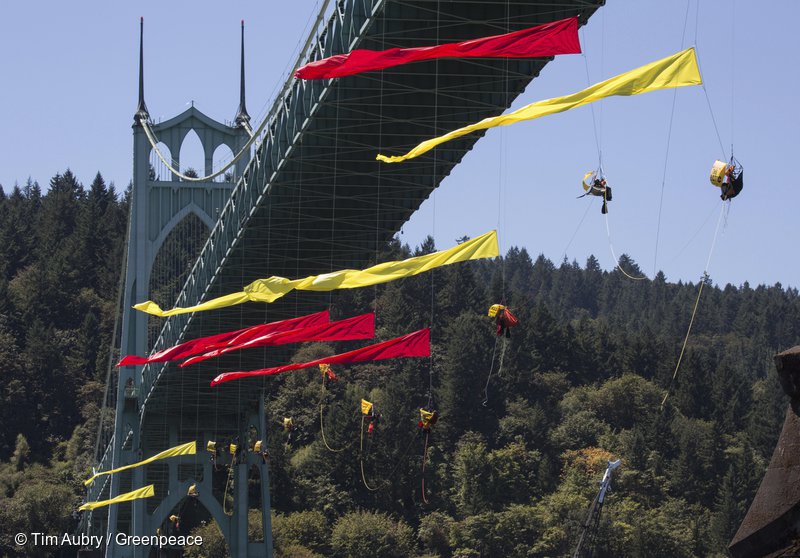

Protesters hang off St. Johns Bridge in Portland, Ore., trying to stop Shell Arctic oil driller from leaving port.
On July 29, 13 bold protesters rappelled down from the St. Johns Bridge, which crosses the entrance to the Portland, Ore., harbor. Lashing themselves together to form a human barrier, they remained in their swaying bivouacs for forty hours, supported by 50 kayaks in the water below and supplied by other protesters on the bridge above.
The activists were making a last-ditch effort to stop arctic oil drilling by preventing an icebreaker, the Fennica, from leaving its Portland drydock and joining the giant Shell Oil Company’s resumption of drilling in the Chukchi Sea in the Arctic region off the coast of Alaska.
Without the icebreaker, it is impossible to proceed with the drilling.


Protesters hang off St. Johns Bridge in Portland, Ore., trying to stop Shell Arctic oil driller from leaving port.
The protesters were from the Greenpeace U.S.A organization, which denounced Shell Oil and its “absolutely pathological plans to drill for oil in the Arctic this summer.” (democracynow.org)
The activists had some initial success: as the behemoth Fennica approached the swaying bodies, it first slowed, and then turned and returned to port.
Enraged, Shell Oil and its allies quickly turned to state repression. On July 30, a federal judge in Alaska ordered Greenpeace to pay an hourly fine starting at $2,500 an hour, and increasing by $2,500 per hour each day until maxing out at $10,000 an hour for the duration of the protests.
On July 31, federal, state and local law enforcement agencies sprang into action. Among those mobilized were the U.S. Coast Guard; the Oregon Department of Transportation, which closed the St. John’s Bridge; the Portland Police Bureau; the Multnomah County Sheriff’s Office; the Clark County Sheriff’s Office; the Clackamas County Sheriff’s Office; and the Oregon State Police. A local judge vowed to force Greenpeace to pay for all the extra expense.
In a SWAT-team type action, police rappelled down with grappling hooks and cut the ropes lashing the protesters together, cleared the kayakers and forced the protesters off the bridge, allowing the icebreaker to barely edge its way through.
Still, a partial victory was claimed: Arctic drilling can only take place in the summertime, which is already half over.
A dangerous, dirty and exploitive business
On the very day that protesters turned back the icebreaker Fennica, Royal Dutch Shell, of which U.S. Shell is a subsidiary, announced that they would lay off 6,500 workers as part of a plan to “manage returns in prolonged oil price downturn.” (Oil & Gas Financial Journal, July 30) Royal Dutch Shell’s second quarter net income dropped 25 percent to $3.4 billion compared with $5.1 billion a year ago. Worldwide oil prices have declined over 50 percent so far in 2015.
Royal Dutch Shell is one of the largest oil companies in the world. Among its various enterprises is a 50/50 partnership with Saudi Aramco, run by the Saudi Arabian monarchy.
Shell is one of the biggest investors in Nigerian oil and even has joint ventures with the Russian government for drilling in Siberia.
Offshore oil drilling is dangerous and dirty, as was shown by the massive Horizon Deepwater disaster in 2010, which killed 11 workers and besmeared the whole Gulf Coast of the United States, leading to hundreds of billions of dollars in damages and untold long-term damage to the environment.
How an oil spill might affect an Arctic environment is still unknown, but most likely it would be worse — much worse.
Shell is drilling at a location which is 2,000 miles from the nearest logistical support in case of an emergency. The region is subject to crushing ice floes, Arctic hurricanes and total darkness for 70 days a year. An oil spill underneath the ice would be an incalculable disaster.
The areas where Shell intends to drill overlap with vital migration routes for whales, walruses and other marine life. Thousands of Indigenous peoples along these routes depend on the Arctic waters for their livelihoods.
Moreover, Shell’s initial efforts at exploratory drilling do not inspire confidence. In 2012, a Shell contracted drilling unit called the Kulluk ran aground and had to be towed home. Another driller, the Noble Discoverer, almost ran aground after being chased by an ice floe. Later on, the operators of the Discoverer pleaded guilty to eight felonies for faulty pollution management systems.
Finally, there are longer term risks, like what finding oil in the Chukchi Sea would mean for climate change. A study published in Nature magazine found that “pulling any oil and gas out of the Arctic was inconsistent with anything below a two-degree-Celsius rise in global warming this century, a point that’s also known as ‘dangerous’ climate change.” (thestranger.com, April 22)
As part of Workers World newspaper’s coverage marking the 50th anniversary of the liberation of…
From the PFLP Central Media Office The following statement from the Popular Front for the…
Newark, New Jersey Over 250 people, representing over 250 New Jersey endorsing community groups, attended…
Special to Workers World The following is a press release issued on April 24, 2025,…
dear Larry Krasner, we heard you sued Elon Musk over his corrupt million election giveaways…
Unions join forces against harassment and deportation of members When 200 immigrant workers – from…